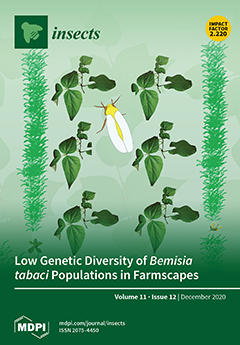The wheat blossom midge
Sitodiplosis mosellana, one of the most disastrous wheat pests, depends highly on olfactory cues to track suitable plants. To better understand the olfactory recognition mechanisms involved in host selection, in the present study we cloned two
S. mosellana
[...] Read more.
The wheat blossom midge
Sitodiplosis mosellana, one of the most disastrous wheat pests, depends highly on olfactory cues to track suitable plants. To better understand the olfactory recognition mechanisms involved in host selection, in the present study we cloned two
S. mosellana adult antenna-specific odorant binding protein (OBP) genes,
SmosOBP12 and
SmosOBP17, and evaluated bacterially expressed recombinant proteins for their selectivity and sensitivity for host wheat volatiles using the fluorescence-based ligand binding assay. The results showed that both SmosOBPs effectively bound alcohol, ester, ketone, and terpenoid compounds. Particularly, SmosOBP12 had significantly higher affinities (K
i < 10.5 μM) than SmosOBP17 (K
i2 > 0.1 μM) to 3-hexanol, 1-octen-3-ol, D-panthenol, 3-carene, (
Z)-3-hexenylacetate, hexyl acetate, methyl salicylate, heptyl acetate, and ethyl heptanoate. Consistently,
S. mosellana females were attracted to all these chemicals in a behavioral assay using Y-tube olfactometer. SmosOBP12 also bound aldehyde, but neither bound alkanes. Notably, SmosOBP12 exhibited strong affinity to ocimene (K
i = 8.2 μM) that repelled
S. mosellana. SmosOBP17, however, was insensitive to this compound. Taken together, our results indicate that SmosOBP12 may play a greater role than SmosOBP17 in perceiving these biologically active plant volatiles.
Full article






